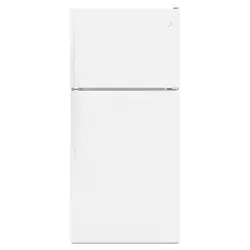Documents: Go to download!
User Manual
- User Manual - (English, French)
- Installation Intructions - (English)
- Dimension Guide - (English)
- Instruction Sheet - (English)
- INSTALLATION INSTRUCTIONS
- REFRIGERATOR USE
- REFRIGERATOR FEATURES
- FREEZER FEATURES
- DOOR FEATURES
- REFRIGERATOR CARE
- TROUBLESHOOTING
- Ice and Water
Table of contents
User manual Refrigerator
INSTALLATION INSTRUCTIONS
Water Pressure
A cold water supply with water pressure of between 30 and 120 psi (207 and 827 kPa) is required to operate the water dispenser and ice maker. If you have questions about your water pressure, call a licensed, qualified plumber.
Reverse Osmosis Water Supply
IMPORTANT: The pressure of the water supply coming out of a reverse osmosis system going to the water inlet valve of the refrigerator needs to be between 30 and 120 psi (207 and 827 kPa).
If a reverse osmosis water filtration system is connected to your cold water supply, the water pressure to the reverse osmosis system needs to be a minimum of 40 to 60 psi (276 to 414 kPa)
If the water pressure to the reverse osmosis system is less than 40 to 60 psi (276 to 414 kPa):
- Check to see whether the sediment filter in the reverse osmosis system is blocked. Replace the filter if necessary.
- Allow the storage tank on the reverse osmosis system to refill after heavy usage
If you have questions about your water pressure, call a licensed, qualified plumber.
Connect the Water Supply
Read all directions before you begin.
IMPORTANT: If you turn the refrigerator on before the water line is connected, turn the ice maker off.
Connect to Water Line
- Unplug refrigerator or disconnect power.
- Turn off main water supply. Turn on nearest faucet long enough to clear line of water.
- Locate a ½" to 1¹⁄₄" (1.25 cm to 3.18 cm) vertical cold water pipe near the refrigerator.
IMPORTANT:
- Make sure it is a cold water pipe.
- Horizontal pipe will work, but drill on the top side of the pipe, not the bottom. This will help keep water away from the drill and normal sediment from collecting in the valve
4. Determine the length of copper tubing you need. Measure from the connection on the lower left rear of refrigerator to the water pipe. Add 7 ft (2.1 m) to allow for cleaning. Use ¹⁄₄" (6.35 mm) O.D. (outside diameter) copper tubing. Be sure both ends of copper tubing are cut square.
5. Using a cordless drill, drill a ¹⁄₄" hole in the cold water pipe you have selected.
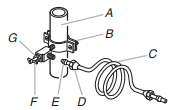
A. Cold water pipe
B. Pipe clamp
C. Copper tubing
D. Compression nut
E. Compression sleeve
F. Shut-off valve
See other models: WRT519SZDT WRT134TFDW WRS322FNAE WRB329DMBB WRB322DMBB
G. Packing nut
6. Fasten the shut-off valve to the cold water pipe with the pipe clamp. Be sure the outlet end is solidly in the ¹⁄₄" drilled hole in the water pipe and that the washer is under the pipe clamp. Tighten the packing nut. Tighten the pipe clamp screws slowly and evenly so washer makes a watertight seal. Do not overtighten or you may crush the copper tubing.
7. Slip the compression sleeve and compression nut on the copper tubing as shown. Insert the end of the tubing into the outlet end squarely as far as it will go. Screw compression nut onto outlet end with adjustable wrench. Do not overtighten.
8. Place the free end of the tubing in a container or sink, and turn on the main water supply. Flush the tubing until water is clear. Turn off the shut-off valve on the water pipe. Coil the copper tubing.
Connect to Refrigerator
- Unplug refrigerator or disconnect power.
- Attach the copper tubing to the valve inlet using a compression nut and sleeve as shown. Tighten the compression nut. Do not overtighten.
- Use the tube clamp on the back of the refrigerator to secure the tubing to the refrigerator as shown. This will help avoid damage to the tubing when the refrigerator is pushed back against the wall.
- Turn shut-off valve ON.
- Check for leaks. Tighten any connections (including connections at the valve) or nuts that leak.
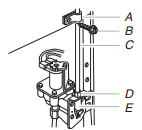
A. Tube clamp
B. Tube clamp screw
C. Copper tubing
D. Compression nut
E. Valve inlet
Refrigerator Doors
Remove Doors and Hinges

⁵⁄₁₆" Hex-Head Hinge Screw
1. Unplug refrigerator or disconnect power.
2. Using a hex-head socket wrench, remove the three ⁵⁄₁₆" hex-head hinge screws from the Top Hinge and lift up to remove the hinge. See Top Hinge graphic. NOTE: Provide additional support for the doors while the hinges are being moved. Do not depend on the door magnets to hold the doors in place while you are working.
3. Lift the freezer door off of the center hinge and set it aside.
4. Remove the washer from the top of the Center Hinge pin.
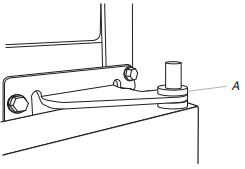
A. Washer
5. Using a hex-head socket wrench and an open-end wrench, remove the three screws from the Center Hinge and remove the hinge. Set aside.
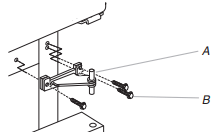
A. Center hinge
B. ⁵⁄₁₆" hex-head hinge screws
6. Remove the washer from the bottom of the Center Hinge pin.
7. Lift the refrigerator door from the Bottom Hinge and set aside.
8. Using a hex-head socket wrench, remove the four ⁵⁄₁₆" hex-head hinge screws from the Bottom Hinge and pull the hinge from the bottom of the refrigerator door.
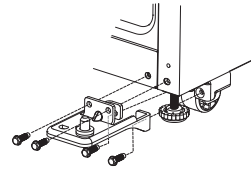
Reverse Top Hinge - Contour door models only
1. Remove the screw attaching the hinge pin to the hinge. Turn the hinge over so that it is pointing in the opposite direction.
2. Place the plastic spacer beneath the hinge so that it will be between the hinge and the cabinet, making sure the holes are aligned.

A. Plastic spacer
B. Hinge pin screw
C. Hinge pin
3. Fasten the Top Hinge to the opposite side of the cabinet, inserting the screws only halfway, so you will be able to replace and align the freezer door later.
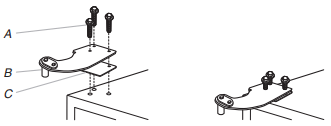
A. ⁵⁄₁₆" hex-head hinge screws
B. Top hinge pin
C. Plastic spacer
Replace Doors and Hinges
IMPORTANT: Provide additional support for the doors while the hinges are being moved. Do not depend on the door magnets to hold the doors in place while you are working.
Install Refrigerator Door
1. Insert the hinge pin into the Bottom Hinge of the refrigerator door and fasten the hinge to the cabinet. Do not tighten completely.

A. Bottom hinge
2. Place the washer on top of the Bottom Hinge pin.
3. Place the refrigerator door onto the Bottom Hinge pin.
4. Measure the distance from the bottom of the refrigerator door to the floor. The distance should be approximately 1⁴⁄₅" (4.6 cm).
NOTE: If necessary, loosen the Bottom Hinge, without removing the screws, adjust the door to the correct height and fully tighten the screws.
Install Freezer Door
- Place washer on the upper hinge pin of the Center Hinge.
- Place the freezer door on the upper hinge pin of the Center Hinge.
- Insert the Top Hinge pin into the drilled hole in the top of the freezer door. Do not tighten the screws completely
- Align the doors so that the bottom of the freezer door aligns evenly with the top of the refrigerator door. Tighten all screws.
NOTE: The distance between the doors should be approximately ³⁄₄" (19 mm).
Reversibility Kit Instructions
If your model came with a Reversibility kit, please use the Brand Badge Placement template and the following instructions to install the Brand Badge on the opposite side of the freezer door.
Freezer Door
- Using the removal tool (provided), remove the brand badge from the freezer door by lifting up the right-hand side and peeling the badge away from the door from right to left. NOTE: To avoid scratching the door, do not use a sharp or metallic object to pry the brand badge from the door.
- Rub a small amount of liquid dish soap over any adhesive residue with your fingers. Rinse the door with warm water and dry with a soft cloth.
- Cut the template along the dotted lines that match the shape of the brand badge.
- Align the edges of the template with the side and top of the freezer door and tape the template to the door.
NOTE: When the template is correctly aligned, the hole in the door, where the handle was, will be within the cutout of the template, as shown.
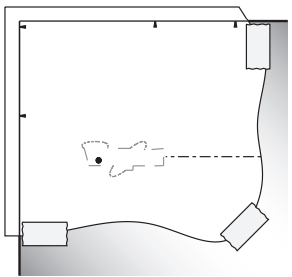
5. Using the cutout as a guide, press the brand badge onto the freezer door making sure that the hole is completely covered.
6. Slowly remove the template.
Adjust the Doors
IMPORTANT: Your refrigerator complies with American Disabilities Act (ADA) guidelines
Door Closing
Your refrigerator has two front adjustable levelers - one on the right and one on the left. If your refrigerator seems unsteady or you want the doors to close easier, adjust the refrigerator's tilt using the following instructions:
1. Turn the leveler to lower or raise that side of the refrigerator.
It may take several turns to adjust the tilt of the refrigerator.
- To raise, turn the leveler to the right.
- To lower, turn the leveler to the left.
NOTE: Having someone push against the top of the refrigerator takes some weight off the levelers and rollers which makes it easier to adjust.
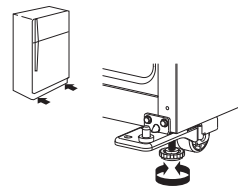
2. Open both doors again to make sure they close as easily as you like. If not, tilt the refrigerator slightly more to the rear by turning both leveling legs to the left; it may take several more turns. NOTE: To keep the refrigerator level, you should turn both leveling legs the same amount.
3. Using a level, be sure that the refrigerator is still level side to side. Readjust if necessary
Door Aligning
If the space between your doors looks uneven, you can adjust it using the following instructions:
- Depending on your model, remove the Top Hinge cover.
- Loosen the top hinge screws using a ⁵⁄₁₆" socket or wrench.
- Have someone hold the door in place or put a spacer between the doors while you tighten the top hinge screws.
- Replace the Top Hinge cover, if removed in Step 1.
REFRIGERATOR USE
Temperature Control
For your convenience, the Temperature control is preset at the factory. When you first install your refrigerator, make sure the control is still preset as shown
Recommended Setting
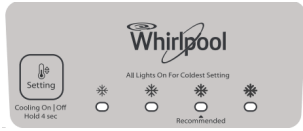
Cooling Off/On
- To turn cooling off, press and hold the Setting button for 4 seconds until all lights are illuminated for 1 second. To turn cooling back on, press and hold the Setting button again for 4 seconds.
NOTE: Neither compartment will cool when the control is set to OFF.

Adjusting the Temperature Control
If you need to adjust the temperature in either the refrigerator or freezer compartment, use the settings listed in the chart below as a guide.
NOTE: Except when starting the refrigerator, do not adjust the control more than one setting at a time. Wait 24 hours between adjustments for the temperature to stabilize.
- Press the SETTING button to toggle among the 4 LED lights which indicate the temperature setting. Reading from left to right, the LED in the first position is the least cold. The LEDs indicate increasingly colder settings as you continue to the right until all 4 LEDs are illuminated.
CONDITION/REASON: REFRIGERATOR too warm
ADJUSTMENT: TEMPERATURE control one setting higher
CONDITION/REASON: FREEZER too warm/Too little ice
ADJUSTMENT: AIRFLOW or TEMPERATURE control one setting higher
CONDITION/REASON: REFRIGERATOR too cold
ADJUSTMENT: TEMPERATURE co ntrol one setting lower
CONDITION/REASON: FREEZER too cold
ADJUSTMENT: AIRFLOW or TEMPERATURE control one setting lower
Airflow Control
The Airflow control regulates the amount of air flowing between the freezer and the refrigerator compartments.
When you plug in the refrigerator for the first time, turn the Airflow control to the Recommended setting.
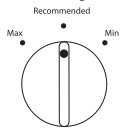
Adjusting the Airflow Control
If you want to temporarily increase the cold airflow to a specific compartment, adjust the control.
- Max - Increase airflow to the freezer.
- Min - Increase airflow to the refrigerator.
IMPORTANT: Once the performance is achieved, return the Airflow control to the Recommended setting to keep the refrigerator operating at optimum efficiency.
CONDITION/REASON: Heavy ice use
ADJUSTMENT: Max
CONDITION/REASON: Hot room temperature
ADJUSTMENT: Max - to maintain ice making production rate
CONDITION/REASON: Large quantity of groceries
ADJUSTMENT: Min - to quickly chill food and beverages
REFRIGERATOR FEATURES
Refrigerator Shelves
The shelves in your refrigerator are adjustable to match your individual storage needs.
Storing similar food items together in your refrigerator and adjusting the shelves to fit different heights of items will make finding the exact item you want easier. It will also reduce the amount of time the refrigerator door is open, and save energy
To remove and replace a shelf:
- Remove items from the shelf.
- Slide the shelf straight out to the stop.
- Depending on your model, lift back or front of the shelf past the stop. Slide shelf out the rest of the way.
- Replace the shelf by sliding the back of the shelf into the track in the wall of the cabinet.
- Guide the front of the shelf into the shelf track. Be sure to slide the shelf in all the way.

Deli Drawer
The deli drawer design allows flexible positioning.
Deli Drawe
To reposition the deli drawer:
- Remove deli drawer.
- Release cover and place it between the desired crossbars.
- Secure the rear clips onto the shelf.
- Replace the deli drawer.
To remove and replace the deli drawer:
- Slide deli drawer out to the stop.
- Lift front of deli drawer with one hand while supporting bottom of drawer with other hand. Slide drawer out the rest of the way.
- Replace the drawer by sliding it back in fully past the drawer stop.
Deli Drawer Cover
To remove and replace the deli drawer cover:
Style 1 - Wire Shelves
- Remove the deli drawer.
- Push the cover back to release the rear clips from the shelf. Tilt the cover up at the front, and then pull it forward.
- Replace the deli drawer cover by fitting the notches and clips on the cover over the rear and center crossbars on the shelf.
- Replace the deli drawer.
Style 2 - Glass Shelves
- Remove the deli drawer.
- Remove items from the shelf.
- Slide the shelf straight out to the stop.
- Slide the deli cover to one side until free.
- Insert the cover into the shelf tracks.
- Slide the shelf back into the refrigerator, and then replace the deli drawer.
NOTE: The deli drawer slides sideways on the shelf to allow for flexible positioning.

FREEZER FEATURES
Freezer Shelf
Depending on your model, the shelf may be wire or glass.
To remove and replace a shelf:
1. Remove items from the shelf.
2. Slide the shelf straight out to the stop.
3. Depending on your model, lift back or front of the shelf past the stop. Slide shelf out the rest of the way.
4. Replace the shelf by sliding the back of the shelf into the track in the wall of the cabinet.
5. Guide the front of the shelf into the shelf track. Be sure to slide the shelf in all the way

Frozen Food Storage Guide
Storage times will vary according to the quality and type of food, the type of packaging or wrap used (should be airtight and moisture-proof), and the storage temperature. Seal the package or container securely to avoid taste and odor transfer throughout the product. Ice crystals inside a sealed package are normal. This simply means that moisture in the food and air inside the package have condensed, creating ice crystals.
Put no more unfrozen food into the freezer than will freeze within 24 hours (no more than 2 to 3 lbs of food per cubic foot [907 to 1,350 g per L] of freezer space). Leave enough space in the freezer for air to circulate around packages. The freezer door must close tightly.
NOTE: For more information on preparing food for freezing, check a freezer guide or reliable cookbook.
DOOR FEATURES
Door Rails
The door rails may be removed for easier cleaning.
To remove and replace the rails:
- Depending on your model, remove the rails by pushing in slightly on the front of the bracket while pulling out on the inside tab. Repeat these steps for the other end.
- Replace the rails by aligning the ends of the brackets with the buttons on the sides of the door liner. Firmly snap bracket and assembly onto the tabs above the shelf as shown.

Door Bins
To remove and replace the bins:
1. Remove the bin by lifting it and pulling it straight out.
2. Replace the bin by sliding it in above the desired support and pushing it down until it stops.

Utility Compartment
The utility compartment may be removed for easier cleaning.
To remove and replace the utility compartment:
- Remove the utility compartment by squeezing against one side while raising the utility compartment up and pulling it straight out.
- Replace the utility compartment by positioning one side in the lock and sliding in the opposite side until it stops.
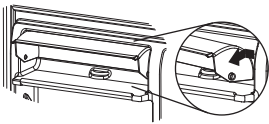
Ice Maker
IMPORTANT: For models with a water filter, after connecting the refrigerator to a water source or replacing the water filter, fill and discard three full containers of ice to prepare the water filter for use.
Turning the Ice Maker On/Off
To turn the ice maker on, simp ly lower the wire shut-off arm.
To manually turn the ice maker off, lift the wire shut-off arm to the Off (arm up) position and listen for the click.
NOTE: Your ice maker has an automatic shutoff. As ice is made, the ice cubes will fill the ice storage bin and the ice cubes will raise the wire shut-off arm to the Off (arm up) position. Do not force the wire shut-off arm up or down.
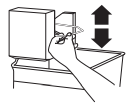
Ice Storage Bin
- Wash the ice storage bin with mild soap and warm water.
- Slide the ice storage bin under the ice maker and push it toward the back as far as it will go.
- Lower the arm on the ice maker to the On position.
NOTE: It usually takes approximately 24 hours for the ice maker to begin producing ice. You may notice the ice has an “off-taste.” If so, discard the first three batches of ice produced. After that the “off-taste” should be gone.
Ice Production Rate
- The ice maker should produce approximately 8 to 12 batches of ice in a 24-hour period. Allow 3 days to completely fill the ice container.
- To increase ice production, lower the freezer and refrigerator temperatures. See “Using the Controls.” Wait 24 hours between adjustments.
Remember
- The quality of your ice will be only as good as the quality of the water supplied to your ice maker. Avoid connecting the ice maker to a softened water supply. Water softener chemicals (such as salt) can damage parts of the ice maker and lead to poor quality ice. If a softened water supply cannot be avoided, make sure the water softener is operating properly and is well maintained.
- Do not use anything sharp to break up the ice in the bin. This can cause damage to the ice storage bin and the dispenser mechanism.
- Do not store anything on top of or in the ice maker or ice storage bin.
REFRIGERATOR CARE
Cleaning
Both the refrigerator and freezer sections defrost automatically. However, clean both sections about once a month to avoid buildup of odors. Wipe up spills immediately.
IMPORTANT:
- Because air circulates between both sections, any odors formed in one section will transfer to the other. You must thoroughly clean both sections to eliminate odors. To avoid odor transfer and drying out of food, wrap or cover foods tightly.
- For stainless steel models, stainless steel is corrosionresistant and not corrosion-proof. To help avoid corrosion of your stainless steel, keep your surfaces clean by using the following cleaning instructions.
To Clean Your Refrigerator:
NOTE: Do not use abrasive or harsh cleaners such as window sprays, scouring cleansers, flammable fluids, muriatic acid, cleaning waxes, concentrated detergents, bleaches or cleansers containing petroleum products on exterior surfaces (doors and cabinet), plastic parts, interior and door liners, or gaskets. Do not use paper towels, scouring pads, or other harsh cleaning tools.
1. Unplug refrigerator or disconnect power.
2. Hand wash, rinse, and dry removable parts and interior surfaces thoroughly. Use a clean sponge or soft cloth and a mild detergent in warm water.
3. Clean the exterior surfaces.
Painted metal: Wash painted metal exteriors with a clean, soft cloth or sponge and a mild detergent in warm water. Rinse surfaces with clean, warm water and dry immediately to avoid water spots.
Stainless steel: Wash stainless steel surfaces with a clean, soft cloth or sponge and a mild detergent in warm water. Rinse surfaces with clean, warm water and dry immediately to avoid water spots.
NOTE: When cleaning stainless steel, always wipe in the direction of the grain to avoid cross-grain scratching.
4. There is no need for routine condenser cleaning in normal home operating environments. If the environment is particularly greasy or dusty, or there is significant pet traffic in the home, the condenser should be cleaned every 2 to 3 months to ensure maximum efficiency
If you need to clean the condenser:
- Remove the base grille.
- Use a vacuum cleaner with a soft brush to clean the grille, the open areas behind the grille, and the front surface area of the condenser. Replace the base grille when finished.
5. Plug in refrigerator or reconnect power.
Changing the Light Bulb
NOTE: Applies to some models.
IMPORTANT: The light bulbs in both the refrigerator and freezer compartments of your new refrigerator use LED technology. If the lights do not illuminate when the refrigerator and/or freezer door is opened, call for assistance or service.
Refrigerator Compartment Light
The refrigerator light bulb is located behind the control.
1. Unplug refrigerator or disconnect power.
2. Remove the light bulb and replace it with an appliance bulb of the same size and shape.
- To replace the LED bulb with an LED bulb, order part number W10565137 (3.6 watts). NOTE: Some LED replacement bulbs are not recommended for wet/damp environments. The refrigerator and freezer compartments are considered to be wet/damp environments. If using a brand of LED bulb other than the recommended LED bulb, before installation, read and follow all instructions on the LED packaging.
- To replace an LED bulb with an incandescent bulb, use only incandescent bulbs for household appliances with a maximum of 60 watts.
3. Plug in refrigerator or reconnect power.
Vacation and Moving Care
Vacations
If You Choose to Leave the Refrigerator On While You’re Away:
- Use up any perishables and freeze other items.
- If your refrigerator has an automatic ice maker and is connected to the household water supply, turn off the water supply to the refrigerator. Property damage can occur if the water supply is not turned off.
- If you have an automatic ice maker, turn off the ice maker. NOTE: Raise the wire shut-off arm to OFF (up) position.
- Empty the ice bin.
If You Choose to Turn Off the Refrigerator Before You Leave:
1. Remove all food from the refrigerator.
2. If your refrigerator has an automatic ice maker:
- Turn off the water supply to the ice maker at least one day ahead of time.
- When the last load of ice drops, raise the wire shut-off arm to the Off (up) position.
3. Turn off the Temperature controls. See “Using the Controls.”
4. Clean refrigerator, wipe it, and dry well.
5. Tape rubber or wood blocks to the tops of both doors to prop them open far enough for air to get in. This stops odor and mold from building up.
Moving
When you are moving your refrigerator to a new home, follow these steps to prepare it for the move.
1. If your refrigerator has an automatic ice maker:
- Turn off the water supply to the ice maker at least one day ahead of time.
- Disconnect the water line from the back of the refrigerator.
- When the last load of ice drops, raise the wire shut-off arm to the Off (up) position.
2. Remove all food from the refrigerator and pack all frozen food in dry ice.
3. Empty the ice bin.
4. Turn off the Temperature controls. See “Using the Controls.”
5. Unplug refrigerator.
6. Clean, wipe, and dry thoroughly.
7. Take out all removable parts, wrap them well, and tape them together so they don’t shift and rattle during the move.
8. Depending on the model, raise the front of the refrigerator so it rolls more easily OR raise the leveling screws so they don't scrape the floor. See “Adjust the Door(s)” or “Door Closing and Door Alignment.”
9. Tape the doors closed and tape the power cord to the back of the refrigerator.
When you get to your new home, put everything back and refer to the “Installation Instructions” section for preparation instructions. Also, if your refrigerator has an automatic ice maker, remember to reconnect the water supply to the refrigerator.
TROUBLESHOOTING
Refrigerator Operation
- Power cord unplugged? Plug into a grounded 3 prong outlet.
- Is outlet working? Plug in a lamp to see if the outlet is working.
- Household fuse blown or circuit breaker tripped? Replace the fuse or reset the circuit breaker. If the problem continues, call an electrician.
- Controls on? Make sure the refrigerator control is ON. See “Using the Controls.”
- New installation? Allow 24 hours following installation for the refrigerator to cool completely.
NOTE: Adjusting the temperature controls to coldest setting will not cool the refrigerator more quickly
The lights do not work
-
Light bulb burned out? Replace light bulb. See “Changing the Light Bulb.”
The motor seems to run too much
-
Your new refrigerator may run longer than your old one due to its high-efficiency compressor and fans. The unit may run even longer if the room is warm, a large food load is added, the door is opened often, or if the door has been left open.
The refrigerator seems noisy
Refrigerator noise has been reduced over the years. Due to this reduction, you may hear intermittent noises from your new refrigerator that you did not notice from your old model. Below are listed some normal sounds with explanations.
- Buzzing - heard when the water valve opens to fill the ice maker
- Pulsating - fans/compressor adjusting to optimize performance.
- Hissing/Rattling - flow of refrigerant, movement of water lines, or from items placed on top of the refrigerator.
- Sizzling/Gurgling - water dripping on the heater during Defrost cycle
- Popping - contraction/expansion of inside walls, especially during initial cooldown
- Water running/dripping - may be heard when ice melts during defrosting and water runs into the drain pan.
- Creaking/Cracking - occurs as ice is being ejected from the ice maker mold
The doors will not close completely or they pop open
- Door blocked open? Move food packages away from door.
- Bin or shelf in the way? Push bin or shelf back in the correct position.
- Crisper cover in the way? Make sure the crisper cover is fully pushed in so that the ba ck rests on the supports.
- Refrigerator not tilted toward the rear? So the doors will close easier, raise the front of the refrigerator so that it tilts slightly downward toward the rear. See “Adjust the Doors.”
- Door closed too quickly? Close the door slowly and firmly to keep the door from popping open.
The door is difficult to open
- Gaskets dirty or sticky? Clean gaskets and contact surfaces with mild soap and warm water. Rinse and dry with soft cloth.
Temperature and Moisture
Temperature is too warm
- New installation? Allow 24 hours following installation for the refrigerator to cool completely.
- Door opened often or left open? Allows warm air to enter refrigerator. Minimize door openings and keep door fully closed.
- Large load of food added? Allow several hours for refrigerator to return to normal temperature.
- Controls set correctly for the surrounding conditions? Adjust the controls a setting colder. Check temperature in 24 hours. See “Using the Controls.”
There is interior moisture buildup
NOTE: Some moisture buildup is normal.
- Humid room? Contributes to moisture buildup.
- Door opened often or left open? Allows humid air to enter refrigerator. Minimize door openings and keep door fully closed.
Ice and Water
The ice maker is not producing ice or not enough ice
- Refrigerator connected to a water supply and the supply shut-off valve turned on? Connect refrigerator to water supply and turn water shut-off valve fully open.
- Kink in the water source line? A kink in the line can reduce water flow. Straighten the water source line.
- Ice maker turned on? Make sure wire shut-off arm or switch (depending on model) is in the On position.
- New installation? Wait 24 hours after ice maker installation for ice production to begin. Allow 3 days to completely fill the ice container.
- Large amount of ice recently removed? Allow 24 hours for ice maker to produce more ice.
- Ice cube jammed in the ice maker ejector arm? Remove ice from the ejector arm with a plastic utensil.
- Reverse osmosis water filtration system connected to your cold water supply? This can decrease water pressure. See “Water Supply Requirements.”
The ice cubes are hollow or small
NOTE: This is an indication of low water pressure.
- Water shut-off valve not fully open? Turn the water shut-off valve fully open.
- Kink in the water source line? A kink in the line can reduce water flow. Straighten the water source line.
- Reverse osmosis water filtration system connected to your cold water supply? This can decrease water pressure. See “Water Supply Requirements.”
- Questions remain regarding water pressure? Call a licensed, qualified plumber.
Off-taste, odor, or gray color in the ice
- New plumbing connections? New plumbing connections can cause discolored or off-flavored ice.
- Ice stored too long? Discard ice. Wash ice bin. Allow 24 hours for ice maker to make new ice.
- Odor transfer from food? Use airtight, moisture proof packaging to store food.
- Are there minerals (such as sulfur) in the water? A water filter may need to be installed to remove the minerals.
